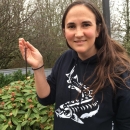
Pacific Lamprey Entosphenus tridentatus is an ecologically important anadromous species native to the Pacific Northwest region and a species of concern in the Columbia River basin (Close et al., 2002, Wang and Schaller 2015). Pacific Lamprey have declined in distribution due to anthropogenic impacts such as dams, climate change climate change
Climate change includes both global warming driven by human-induced emissions of greenhouse gases and the resulting large-scale shifts in weather patterns. Though there have been previous periods of climatic change, since the mid-20th century humans have had an unprecedented impact on Earth's climate system and caused change on a global scale.
Learn more about climate change , and other habitat alterations (Clemens et al. 2017, Wang et al. 2020, Hess et al. 2021). As research and conservation efforts increase for Pacific Lamprey and other lampreys (including Lampetra spp.), marking and tagging techniques should be further evaluated for use in future studies and monitoring. Common tagging methods previously evaluated for larval lamprey include coded wire tags (CWT), visible implant elastomer tags (VIE), and passive integrated transponder tags (PIT) (e.g., Stone et al. 2006, Meeuwig et al. 2007, Silver et al. 2009, Hanson and Barron 2017, Moser et al. 2017). However, these tagging methods have limitations, such as CWTs require euthanization to retrieve the tag code, VIE tags have reduced detectability after metamorphosis, and all likely have minimum body size thresholds for tag implantation (Hanson and Barron 2017, Meeuwig et al. 2007). Many of these techniques also require fish anesthetization (CWT, VIE, PIT). In our study, we investigated several simple batch marking techniques to assess mortality and effectiveness for larval lampreys.




